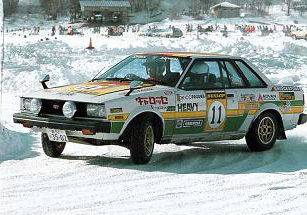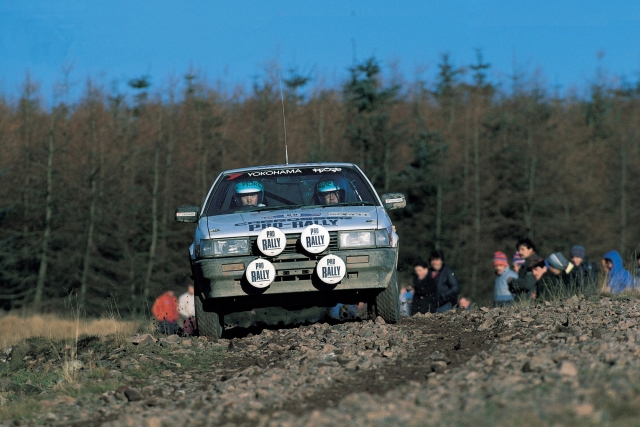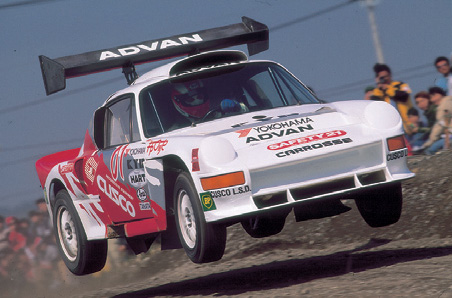If you’ve been around Japanese cars for any appreciable time, you are probably familiar with Cusco racing parts. For many, the very step into the wide world of mods was a Cusco strut tower brace. What is perhaps less known, however, is that the company has a long history of motorsports because its founder, Yuji Kase, was a rallying fanatic. He was so adamant about racing, in fact, that made his staff go do it professionally. Cusco turned 40 years old this month. Here’s a look at some of their most memorable racing exploits.
Cusco’s parent company, Carrosser, was established December 1977 as a rally shop in Gunma Prefecture. Kase had aspirations as a rally driver, and entered various Japanese rally stages in cars such as his TE71 Toyota Corolla. He won many events, and during those early racing days, Kase was already making various car parts based on prototyping in his own rally cars.
In 1984, Kase entered his AE86 in the World RAC (today’s FIA WRC) and won a few rounds in the Group N class. It featured Carrosser’s own MFE fuel-trimming ECU, which Kase designed. This product triggered the introduction of the name “Cusco,” inspired by the ancient capital of the Incan Empire, a city known for having advanced scientific culture and technology.
What we know as Cusco today is actually just one brand under the Carrosser umbrella. Cusco makes the aftermarket tuning parts, while Carrosser handles competition parts and is officially sanctioned by the Japan Automobile Federation. There are other Carrosser sub-brands as well: Safety 21, which makes safety equipment, and Vacanza, which makes VIP-style suspensions for image rather than performance.
By the late 80s, Cusco’s reach had expanded significantly. Kase stepped away from the driver’s seat and signed Kiyoshi Inoue, who drove an E39 Mitsubishi Galant VR-4 from 1989-95. Inoue became Cusco’s ace driver, and competed in WRC. In 1989, the Galant took first place at the Acropolis Rally as a Group N class car, making Inoue the first Japanese driver to win the rally.
When the original CD9 Mitsubishi Lancer Evolution came out, Kase bought three of them and built rally machines for his team, Haruo Oshima, Yukihiko Sakurai, and himself. Then he put them on the grid for the express purpose of proving that each of the engineers that develop Cusco products were capable of truly competing as a driver and team operator as well.
In the two years they ran, the three of them took five overall wins at the All-Japan Rally. In 1993 Team Cusco placed second overall, and in 1993 they took both first and second place in the championships. As a project it was an huge success, especially with founder Kase returning to the driver’s seat of a rally car and demonstrating he was still very much on top of his game as a developer of cars and as a driver.
From 1991-95, Carrosser campaigned a rather unconventional rally car in the All-Japan Dirt Trials, a heavily modified Mitsubishi GTO in the D Class. In its second season, the GTO placed on the podium four times.
As a side note, the D Class spawned some of the wildest looking rally cars ever built. Here’s the Carrosser GTO going head to head against an heavily modified Suzuki Swift driven by Monster Tajima himself (you can see the double-spoiler theme that would carry over into his Pikes Peak machines).
As its run with Mitsubishi neared an end, Cusco inked a deal with Subaru and entered its most successful era yet. Yukihiko Sakurai drove Cusco’s lead car in WRC Group A, in collaboration with the UK’s Team Prodrive. With this car, Cusco competed at top manufacturer levels and put the Cusco livery on the map as a competition supplier brand.
In the late 90s, Kase decided to enter his first non-rally series, the Japan Grand Touring Championships, or JGTC. Despite Cusco’s long history of dirt trial operations, this was its first serious attempt at a formidable road racing series.
For this, Kase’s and his team’s developed went all-out with their entry car. Aside from the engine and standard-issue required parts, just about every area of the chassis where modifications were legal was thoroughly redesigned and tuned. Of these parts, many were based on Cusco’s existing product lineup. The rest were prototypes using the Impreza as a test mule.
From 1997 to 2008, the Impreza underwent many revisions. It achieved two overall wins, three pole positions, and, in the Malaysia round of SuperGT in its final season, achieved a new record: the first win for an AWD vehicle.
At the same time, Kase never quit rallying. From 1996-2004, he campaigned the Carrosser Super D in the All-Japan Dirt Trial. An aluminum monocoque open-construction class car, it featured a mid-engine EG33 Subaru flat-6 tuned at over 800 horsepower and electronic center differential control. With Cusco’s own long stroke suspension, it was said to be extremely balanced at even high speeds, despite its dirt track-derived chassis layout.
From 1996-99, it wore a Porsche-like body shell, and from 2000-04, that was replaced with a Subaru Impreza pattern body shell. It amassed a whopping total of five season championship trophies, and four runner-up season trophies.
In more recent years, Cusco has been active in tarmac competitions, especially in gymkhana. The EG6 Civic was current president Tsutomu Nagase’s personal entry, and from 1995-99 he never missed any of the 44 rounds of the All-Japan Gymkhana Series. The car and events were key to development of the Cusco 1-way LSD for front-wheel-drive platforms, and Nagase finished in points for every event as well, and won the Class C championship in 1999.
In its 40 years of operation, Cusco has built a wider variety of race cars than most tuners. For a company of its size (employees still number in the low double digits) it enjoys brand recognition that’s pretty enviable and maintains a fairly impressive list of motorsports victories. While Kase is no longer heading the company he founded on a day to day basis, we’re sure he would be happy to see the tradition he established — of having the people making the parts go racing — is still being carried out.
Special thanks to Yuki Iwamoto and Moto Miwa. Images courtesy of Cusco.
















Holy crap, this is cool.
Awesome story about a truly top-notch parts maker!!!!
No truer story line than “For many, the very step into the wide world of mods was a Cusco strut tower brace”.
My 180SX had one front & back, my 86 has a rear one (carbon), & I just bought R32 GT-R a full-carbon rear strut brace for Christmas!! 🙂
Carrosser/Cusco is as important as either HKS or Trust/GReddy. Here’s to another great 40yrs & beyond!!!!!
Ha, I got one for my AE86. Still have it.
Thanks for this piece. I never knew Cusco’s origins were with rally.
The Cusco cars from Granturismo 4 5 and 6 are some of the best GT300 cars in the game.
Thank you for the history of the company guys.
Last I heard 2011, Cusco made about 30 units of Proton Satria Neo for Group N
HELLO!
I am the current owner of Kiyoshi Inoue’s E39 VR4 (GMG 9580) and am looking to find information and pics of the car whilst it was rallied by Kiyoshi in those early years.
GMG 9580 was imported to Jersey UK from Japan, the reg number became J52369 and was owned by Peter Collinson of Blaze Motors.
Hideaki Miyoshi also drove J53269 in the UK Shell Oils rally with John Meadows as co-driver on 02/09/1989, the car was white with green stripes and came 2nd.
Also driven by Geoff Jones in the Audi Sport rally, 1990.
J52369 was eventually imported into the UK and became Q881 GDH.
Any information would be great.
Please email chris@kitcar.plus.com.
Just tried posting a question but not working.
Try again…
I am the current owner of the VR4 that Kiyoshi Inoue drove, the registration number was GMG 9580 and built by Carrosser in Gunma Japan.
The car became J53269 when imported into Jersey UK by Peter Collinson of Blaze Motors.
It was also known as BLAZE 01 and was hired out by Blaze Motors.
Also driven By Miyoshi.
Does anybody have details or pics of the car?
. Chris.
Amazing!! History in the making!!